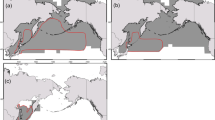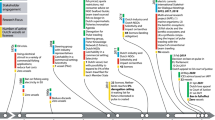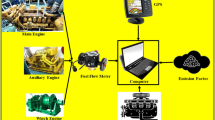Abstract
Discarding of juvenile fish is a wellrecognised problem in shrimp fisheries. In manycases, these fish are commercial species that,if not caught, could increase the productivityof other fisheries. In January 2003, Europeanlegislation was implemented by Member Statesrequiring all vessels fishing for brown shrimpto use selective trawls in order to minimisethe bycatch of other commercial species. Incomplying with the regulations, however, thecatch rate of the target species (the shrimp)is likely to be reduced. In this paper, we usea bioeconomic model to assess the impact ofbycatch reduction devices on fishing effort,catch and profitability in the European Crangon fisheries. The potential benefits (interms of higher future yields and consequentlyhigher profits) to the white-fish fisheries arealso estimated. From the model results, theregulation is expected to result in a netreduction in the profitability of the shrimpfishers. However, the benefits to thewhite-fish fishers is expected to more thanoffset this cost, resulting in an overall netbenefit.
Similar content being viewed by others
References
Anderson, L. G. (1982), ‘The Economics of Multi-purpose Fleet Behavior’, in L. J. Mirman and D. F. Spulber, eds., Essays in the Economics of Renewable Resources (pp. 203–226). Amsterdam: New York and Oxford: North-Holland Publishing Company.
Asche, F., K. G. Salvanes and F. Steen (1997), ‘Market Delineation and Demand Structure’, American Journal of Agricultural Economics 79(1), 139–150.
Barten, A. P. and L. J. Bettendorf (1989), ‘Price Formation of Fish’, European Economic Review 33, 1509–1525.
Branstetter, S. (1996), ‘Re:More Bycatch’, Posting to the ‘FISHFOLK’ mail listfishfolk@mitvma. mit.edu, 7 November 1996.
Brooke, A., D. Kendrick and A. Meeraus (1992), GAMS: A User's Guide. USA: Boyd and Fraser Publishing Company.
Burrows, M. T., S. J. Gontarek, R. D. M. Nash and R. N. Gibson (2001), ‘Shrimp Predation on 0-group Plaice: Contrasts between Field Data and Predictions of an Individual-based Model’, Journal of Sea Research 45(3-4), 243–254.
Burton, M. P. (1992), ‘The Demand for Wet Fish in Great Britain’, Marine Resource Economics 7, 57–66.
Collins, P. (1995), Regional Price Determination for Major Shellfish and Crustacean Species in the English Channel Fishery. MSc Fisheries Economics Dissertation, University of Portsmouth.
Concerted Action (2002), Economic Performance of Selected European Fishing Fleets, Annual Report 2002. LEI-DLO, The Hague.
Dunn, M. R., S. D. Potten and D. Whitmarsh (1995), Further Economic Evaluation of the Bass Fishery in England and Wales 1992/93 (CEMARE Research Report No. 30). CEMARE, University of Portsmouth, UK.
Dupouy, H., J. P. Vacherot and M. Meillat (1998), Selective Trials for the By-catch of Brown Shrimp (Crangon crangon) in the Estuary of the Vilaine (Southern Brittany, France). IFREMERWorking Paper presented at the ICES Shrimp Meeting, Port-en-Bessin, France, May 1998.
Graham, G. N. (1998), Reduction of By-catch in the Brown Shrimp, C. crangon, Fisheries of the Wash and Humber Estuaries. PhD thesis at the University of Lincolnshire and Humberside.
Graham, G. N. (2003), ‘By-catch Reduction in the Brown Shrimp, Crangon crangon, Fisheries Using a Rigid Separation Nordmøre Grid (gate)’, Fisheries Research 59(3), 393–407.
Granger, C. W. J. (1969), ‘Investigating Causal Relationships be Econometric Models and Crossspectral Methods’, Econometrica 37, 24–36.
Griffin, W. L. and C. Oliver (1991), Evaluation of the Economic Impacts of Turtle Excluder Devices (TEDs) on the Shrimp Production Sector in the Gulf of Mexico. MARFIN Project No. NA-87-WC-H-06139. Agricultural Economics Department, Texas A&M University College Station.
Hendrickson, H. M and W. L. Griffin (1993), ‘An Analysis of Management Policies for Reducing Shrimp Bycatch in the Gulf of Mexico’, North American Journal of Fisheries Management 13(4), 686–697.
ICES (International Council for the Exploitation of the Sea) (1999 and earlier issues), Report of the Working Group on Crangon fisheries 1999. ICES, Copenhagen.
Ioannidis, C. and D. Whitmarsh (1987), ‘Price Formation in Fisheries’, Marine Policy 11, 143–145.
Jaffry, S., S. Pascoe and C. Robinson (1999), ‘Long Run Flexibilities for High Valued UK Fish Species: A Cointegration Systems Approach’, Applied Economics 31, 473–481.
Jørgensen, H. P. (1990), ‘Baltic Sea Cod Price Responsiveness’, in H. Frost and P. Anderson, eds., Proceedings of the 4th Biennial Conference of the International Institute of Fisheries Economics and Trade, 7-12 August, 1988, Esbjerg, Denmark, Volume 1 (pp. 408–423). DIFER, Esbjerg.
Maddala, G. S. and I. M. Kim (1998), Unit Roots, Cointegration and Structural Change. Cambridge: Cambridge University Press.
Mardle S., S. Pascoe, M. Tamiz and D. E. Jones (2000), ‘Resource Allocation in the North Sea Demersal Fisheries: A Goal Programming Approach’, Annals of Operations Research 94, 321–342.
Polet, H. (2002), ‘Selectivity Experiments with Sorting Grids ion the North Sea Brown Shrimp (Crangon crangon) Fishery’, Fisheries Research 54(2), 217–233.
Revill, A., N. Graham and C. Radcliffe (1998), ‘The Economic and Biological Impacts of Discarding in the UK (East coast) Crangon crangon Fishery’, in P. Salz, ed., Proceedings of the Xth Annual Conference of the European Association of Fisheries Economists. The Hague: Agricultural Economics Research Institute (LEI).
Revill, A., S. Pascoe, C. Radcliffe, S. Riemann, F. Redant, H. Polet, U. Damm, T. Neudecker, P. S. Kristensen and D. Jensen (1999), The Economics and Biological Consequences of Discarding in the Crangon Fisheries (The ECODISC Project - EU (DG XIV A:3) Project 97/SE/23). Final Report to the European Commission, University of Lincolnshire and Hamberside.
Temming, A. and U. Damm (1998), Life Cycle of Crangon crangon in the North Sea: A Simulation of the Timing of Recruitment as a Function of the Seasonal Temperature Signal. Paper Presented at the ICES Shrimp Meeting, Port-en-Bessin, France, May 1998.
Ward, J. M. (1994), ‘The Bioeconomic Implications of a Bycatch Reduction Device as a Stock Conservation Management Measure’, Marine Resource Economics 9(3), 227–240.
Zijlstra, J. J., R. Dapper and J. I. J. Witte (1982). ‘The Settlement, Growth and Mortality of Post Larval Plaice (Plueronectes Platessa) in the Western Waddensea’, Netherlands Journal of Sea Research 15, 250–272.
Author information
Authors and Affiliations
Rights and permissions
About this article
Cite this article
Pascoe, S., Revill, A. Costs and Benefits of Bycatch Reduction Devices in European Brown Shrimp Trawl Fisheries. Environmental and Resource Economics 27, 43–64 (2004). https://doi.org/10.1023/B:EARE.0000016794.43136.0a
Issue Date:
DOI: https://doi.org/10.1023/B:EARE.0000016794.43136.0a




